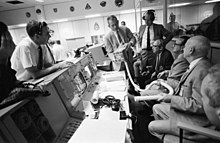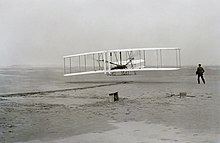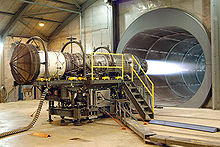Aerospace engineering
 | |
| Occupation | |
|---|---|
| Names | Aerospace engineer |
Occupation type | Profession |
Activity sectors | Aeronautics,astronautics,science |
| Description | |
| Competencies | Technical knowledge, analytical skills, management skills (see alsoglossary of aerospace engineering) |
Education required | Bachelor's degree[1][2] |
Fields of employment | Technology,science,space exploration,military |
| Part of a series on |
| Astrodynamics |
|---|
Aerospace engineeringis the primary field ofengineeringconcerned with the development ofaircraftandspacecraft.[3]It has two major and overlapping branches:aeronauticalengineering andastronauticalengineering.Avionicsengineering is similar, but deals with theelectronicsside of aerospace engineering.
"Aeronautical engineering" was the original term for the field. As flight technology advanced to include vehicles operating inouter space,the broader term "aerospaceengineering "has come into use.[4]Aerospace engineering, particularly the astronautics branch, is often colloquially referred to as "rocket science".[5][a]
Overview[edit]
Flight vehicles are subjected to demanding conditions such as those caused by changes inatmospheric pressureandtemperature,withstructural loadsapplied upon vehicle components. Consequently, they are usually the products of various technological and engineering disciplines includingaerodynamics,Air propulsion,avionics,materials science,structural analysisandmanufacturing.The interaction between these technologies is known as aerospace engineering. Because of the complexity and number of disciplines involved, aerospace engineering is carried out by teams of engineers, each having their own specialized area of expertise.[7]
History[edit]

The origin of aerospace engineering can be traced back to the aviation pioneers around the late 19th to early 20th centuries, although the work of SirGeorge Cayleydates from the last decade of the 18th to the mid-19th century. One of the most important people in the history of aeronautics[8]and a pioneer in aeronautical engineering,[9]Cayley is credited as the first person to separate the forces ofliftanddrag,which affect any atmospheric flight vehicle.[10]
Early knowledge of aeronautical engineering was largely empirical, with some concepts and skills imported from other branches of engineering.[11]Some key elements, likefluid dynamics,were understood by 18th-century scientists.[12]
In December 1903, theWright Brothersperformed the first sustained, controlled flight of a powered, heavier-than-air aircraft, lasting 12 seconds. The 1910s saw the development of aeronautical engineering through the design ofWorld War Imilitary aircraft.
Between World Wars I and II, great leaps were made in the field, accelerated by the advent of mainstream civil aviation. Notable airplanes of this era include theCurtiss JN 4,theFarman F.60 Goliath,andFokker Trimotor.Notable military airplanes of this period include theMitsubishi A6M Zero,theSupermarine Spitfireand theMesserschmitt Bf 109from Japan, United Kingdom, and Germany respectively. A significant development came with the first operationalJet engine-powered airplane, theMesserschmitt Me 262which entered service in 1944 towards the end of the Second World War.[13]
The first definition of aerospace engineering appeared in February 1958,[4]considering the Earth's atmosphere and outer space as a single realm, thereby encompassing both aircraft (aero) and spacecraft (space) under the newly coined termaerospace.
The Cold War[edit]
In response to the USSR launching the first satellite,Sputnik,into space on October 4, 1957, U.S. aerospace engineers launched thefirst American satelliteon January 31, 1958. TheNational Aeronautics and Space Administrationwas founded in 1958 after theSputnik crisis.In 1969,Apollo 11,the first human space mission to theMoon,took place. It saw threeastronautsenter orbit around the Moon, with two,Neil ArmstrongandBuzz Aldrin,visiting the lunar surface. The third astronaut,Michael Collins,stayed in orbit to rendezvous with Armstrong and Aldrin after their visit.[14]

An important innovation came on January 30, 1970, when theBoeing 747made its first commercial flight from New York to London. This aircraft made history and became known as the "Jumbo Jet" or "Whale"[15]due to its ability to hold up to 480 passengers.[16]
1976: First passenger supersonic aircraft[edit]
Another significant development came in 1976, with the development of the first passengersupersonicaircraft, theConcorde.The development of this aircraft was agreed upon by the French and British on November 29, 1962.[17]
On December 21, 1988, theAntonov An-225Mriyacargo aircraft commenced its first flight. It holds the records for the world's heaviest aircraft, heaviest airlifted cargo, and longest airlifted cargo, and has the widest wingspan of any aircraft in operational service.[18]
On October 25, 2007, theAirbus A380made its maiden commercial flight from Singapore to Sydney, Australia. This aircraft was the first passenger plane to surpass theBoeing 747in terms of passenger capacity, with a maximum of 853. Though development of this aircraft began in 1988 as a competitor to the 747, the A380 made its first test flight in April 2005.[19]
Elements[edit]



Some of the elements of aerospace engineering are:[20][21]
- Radar cross-section– the study of vehicle signature apparent toremote sensingbyradar.
- Fluid mechanics– the study offluid flowaround objects. Specificallyaerodynamicsconcerning the flow of air over bodies such aswingsor through objects such aswind tunnels(see alsoliftandaeronautics).
- Astrodynamics– the study oforbital mechanicsincluding prediction of orbital elements when given a select few variables. While few schools in the United States teach this at the undergraduate level, several have graduate programs covering this topic (usually in conjunction with the Physics department of said college or university).
- StaticsandDynamics(engineering mechanics) – the study of movement, forces, moments in mechanical systems.
- Mathematics– in particular,calculus,differential equations,andlinear algebra.
- Electrotechnology– the study ofelectronicswithin engineering.
- Propulsion– the energy to move a vehicle through the air (or in outer space) is provided byinternal combustion engines,jet enginesandturbomachinery,orrockets(see alsopropellerandspacecraft propulsion). A more recent addition to this module iselectric propulsionandion propulsion.
- Control engineering– the study ofmathematical modelingof thedynamicbehavior of systems and designing them, usually using feedback signals, so that their dynamic behavior is desirable (stable, without large excursions, with minimum error). This applies to the dynamic behavior of aircraft, spacecraft, propulsion systems, and subsystems that exist on aerospace vehicles.
- Aircraft structures– design of the physical configuration of the craft to withstand the forces encountered during flight. Aerospace engineering aims to keep structures lightweight and low-cost while maintaining structural integrity.[22]
- Materials science– related to structures, aerospace engineering also studies the materials of which the aerospace structures are to be built. New materials with very specific properties are invented, or existing ones are modified to improve their performance.
- Solid mechanics– Closely related to material science is solid mechanics which deals with stress and strain analysis of the components of the vehicle. Nowadays there are several Finite Element programs such as MSC Patran/Nastran which aid engineers in the analytical process.
- Aeroelasticity– the interaction of aerodynamic forces and structural flexibility, potentially causingflutter,divergence, etc.
- Avionics– the design and programming ofcomputer systemson board an aircraft or spacecraft and thesimulationof systems.
- Software– the specification, design, development, test, and implementation ofcomputer softwarefor aerospace applications, includingflight software,ground controlsoftware, test & evaluation software, etc.
- Risk and reliability– the study of risk and reliability assessment techniques and the mathematics involved in the quantitative methods.
- Noise control– the study of the mechanics of sound transfer.
- Aeroacoustics– the study of noise generation via either turbulent fluid motion or aerodynamic forces interacting with surfaces.
- Flight testing– designing and executing flight test programs in order to gather and analyze performance andhandling qualitiesdata in order to determine if an aircraft meets its design and performance goals and certification requirements.
The basis of most of these elements lies in theoreticalphysics,such asfluid dynamicsfor aerodynamics or theequations of motionforflight dynamics.There is also a largeempiricalcomponent. Historically, this empirical component was derived from testing of scale models and prototypes, either inwind tunnelsor in the free atmosphere. More recently, advances incomputinghave enabled the use ofcomputational fluid dynamicsto simulate the behavior of the fluid, reducing time and expense spent on wind-tunnel testing. Those studying hydrodynamics orhydroacousticsoften obtain degrees in aerospace engineering.
Additionally, aerospace engineering addresses the integration of all components that constitute an aerospace vehicle (subsystems including power,aerospace bearings,communications,thermal control,life support system,etc.) and its life cycle (design, temperature, pressure,radiation,velocity,lifetime).
Degree programs[edit]
Aerospace engineering may be studied at theadvanced diploma,bachelor's,master's,andPh.D.levels in aerospace engineering departments at many universities, and inmechanical engineeringdepartments at others. A few departments offer degrees in space-focused astronautical engineering. Some institutions differentiate between aeronautical and astronautical engineering. Graduate degrees are offered in advanced or specialty areas for the aerospace industry.
A background in chemistry, physics, computer science and mathematics is important for students pursuing an aerospace engineering degree.[23]
In popular culture[edit]
The term "rocket scientist"is sometimes used to describe a person of greatintelligencesince rocket science is seen as a practice requiring great mental ability, especially technically and mathematically. The term is used ironically in the expression "It's not rocket science" to indicate that a task is simple.[24]Strictly speaking, the use of "science" in "rocket science" is a misnomer since science is about understanding the origins, nature, and behavior of the universe; engineering is about using scientific and engineering principles to solve problems and develop new technology.[5][6]The moreetymologicallycorrect version of this phrase would be "rocket engineer". However, "science" and "engineering" are often misused as synonyms.[5][6][25]
See also[edit]
- American Institute of Aeronautics and Astronautics
- American Helicopter Society International
- Flight test
- Glossary of aerospace engineering
- Index of aerospace engineering articles
- List of aerospace engineering schools
- List of aerospace engineers
- List of Russian aerospace engineers
- Sigma Gamma Tau– aerospace engineering honor society
- Space Power Facility
Footnotes[edit]
References[edit]
- ^"Required Education".study.com.Retrieved2015-06-22.
- ^"Education, Aerospace Engineers".myfuture.com. Archived fromthe originalon 2015-06-22.Retrieved2015-06-22.
- ^Encyclopedia of Aerospace Engineering.John Wiley & Sons,2010.ISBN978-0-470-75440-5.
- ^abStanzione, Kaydon Al (1989). "Engineering".Encyclopædia Britannica.Vol. 18 (15 ed.). Chicago. p. 563.
{{cite encyclopedia}}:CS1 maint: location missing publisher (link) - ^abcdNASA (2008). Steven J. Dick (ed.).Remembering the Space Age: Proceedings of the 50th Anniversary Conference(PDF).p. 92.
The term "rocket scientist" is a misnomer used by the media and in popular culture and applied to a majority of engineers and technicians who worked on the development of rockets with von Braun. It reflects a cultural evaluation of the immense accomplishments of the team but is nevertheless incorrect....
- ^abcPetroski, Henry (23 November 2010)."Engineering Is Not Science".IEEE Spectrum.Retrieved21 June2015.
Science is about understanding the origins, nature, and behavior of the universe and all it contains; engineering is about solving problems by rearranging the stuff of the world to make new things.
- ^"Career: Aerospace Engineer".Career Profiles.The Princeton Review. Archived fromthe originalon 2006-05-09.Retrieved2006-10-08.
Due to the complexity of the final product, an intricate and rigid organizational structure for production has to be maintained, severely curtailing any single engineer's ability to understand his role as it relates to the final project.
- ^"Sir George Cayley".flyingmachines.org.Retrieved2009-07-26.
Sir George Cayley is one of the most important people in the history of aeronautics. Many consider him the first true scientific aerial investigator and the first person to understand the underlying principles and forces of flight.
- ^"Sir George Cayley (British Inventor and Scientist)".Britannica. n.d.Retrieved2009-07-26.
English pioneer of aerial navigation and aeronautical engineering and designer of the first successful glider to carry a human being aloft.
- ^"Sir George Cayley".U.S. Centennial of Flight Commission. Archived fromthe originalon 24 February 2014.Retrieved31 January2016.
A wealthy landowner, Cayley is considered the father of aerial navigation and a pioneer in the science of aerodynamics. He established the scientific principles for heavier-than-air flight and used glider models for his research. He was the first to identify thefour forces of flight--thrust, lift, drag, and weight—and to describe the relationship each had with the other.
- ^Kermit Van Every(1988). "Aeronautical engineering".Encyclopedia Americana.Vol. 1. Grolier Incorporated.
- ^John D. Anderson Jr. (2010)."Brief History of the Early Development of Theoretical and Experimental Fluid Dynamics".Encyclopedia of Aerospace Engineering.RetrievedApril 2,2023.
The fundamental advances in fluid dynamics that occurred in the 18th century began with the work of Daniel Bernoulli (1700–1782).
- ^"Messerschmitt Me 262 A-1a Schwalbe (Swallow)".RetrievedNovember 20,2022.
- ^"A Brief History of NASA".NASA. Archived fromthe originalon 2010-11-18.Retrieved2012-03-20.
- ^German, Kent."Boeing 747: Queen of the Skies for 50 years".CNET.Retrieved2019-09-11.
- ^"Boeing 747–100 – Specifications – Technical Data / Description".www.flugzeuginfo.net.Retrieved2019-09-11.
- ^Zhang, Benjamin."The Concorde made its final flight 15 years ago and supersonic air travel has yet to recover — here's a look back at its awesome history".Business Insider.Retrieved2019-09-10.
- ^Guy, Jack (February 28, 2022)."World's largest plane destroyed in Ukraine".CNN.RetrievedNovember 20,2022.
- ^"History of the Airbus A380".interestingengineering.com.2019-03-31.Retrieved2019-09-11.
- ^"Aerospace Engineering definition"(PDF).Atlantic International University.RetrievedApril 30,2023.
- ^Gruntman, Mike (September 19, 2007)."The Time for Academic Departments in Astronautical Engineering".AIAA SPACE 2007 Conference & Exposition Agenda.AIAA SPACE 2007 Conference & Exposition.American Institute of Aeronautics and Astronautics(AIAA). Archived fromthe originalon October 18, 2007.
- ^"Aircraft Structures in Aerospace Engineering".Aerospace Engineering, Aviation News, Salary, Jobs and Museums.Archived fromthe originalon 2015-11-09.Retrieved2015-11-06.
- ^"Entry education, Aerospace Engineers".myfuture.com. Archived fromthe originalon 2015-06-22.Retrieved2015-06-22.
- ^Bailey, Charlotte (7 November 2008)."Oxford compiles list of top ten irritating phrases".The Daily Telegraph.Archivedfrom the original on 2022-01-11.Retrieved2008-11-18.
10 – It's not rocket science
- ^Neufeld, Michael.Von Braun: Dreamer of Space, Engineer of War(First ed.). Vintage Books. pp. xv.
There has been a deep-rooted failure in the English-speaking media and popular culture to grapple with the distinction between science and engineering.
Further reading[edit]
- Dharmahinder Singh Chand.Aero-Engineering Thermodynamics.Knowledge Curve, 2017.ISBN978-93-84389-16-1.
External links[edit]
- NDTAeroTech.com, The Online Community for Aerospace NDT Professionals
- Kroo, Ilan."Aircraft Design: Synthesis and Analysis".Stanford University. Archived fromthe originalon 23 February 2001.Retrieved17 January2015.
- Air Service Training Aviation Maintenance UK
- Question and AnswerArchived2021-11-14 at theWayback Machine
- DTIC ADA032206: Chinese-English Aviation and Space Dictionary

